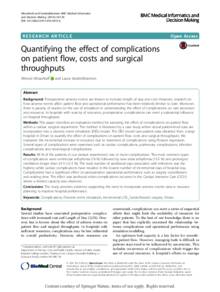وثيقة
Quantifying the effect of complications on patient flow, costs and surgical throughputs.
المعرف
DOI: 10.1186/s12911-016-0372-6
المساهمون
Vanderbloemen, Laura., مؤلف
الناشر
BioMed Central Ltd.
ميلادي
2016-10
اللغة
الأنجليزية
الملخص الإنجليزي
Background: Postoperative adverse events are known to increase length of stay and cost. However, research on how adverse events affect patient flow and operational performance has been relatively limited to date. Moreover, there is paucity of studies on the use of simulation in understanding the effect of complications on care processes and resources. In hospitals with scarcity of resources, postoperative complications can exert a substantial influence on hospital throughputs. Methods: This paper describes an evaluation method for assessing the effect of complications on patient flow within a cardiac surgical department. The method is illustrated by a case study where actual patient-level data are incorporated into a discrete event simulation (DES) model. The DES model uses patient data obtained from a large hospital in Oman to quantify the effect of complications on patient flow, costs and surgical throughputs. We evaluated the incremental increase in resources due to treatment of complications using Poisson regression. Several types of complications were examined such as cardiac complications, pulmonary complications, infection complications and neurological complications. Results: 48 % of the patients in our dataset experienced one or more complications. The most common types of complications were ventricular arrhythmia (16 %) followed by new atrial arrhythmia (15.5 %) and prolonged ventilation longer than 24 h (12.5 %). The total number of additional days associated with infections was the highest, while cardiac complications have resulted in the lowest number of incremental days of hospital stay. Complications had a significant effect on perioperative operational performance such as surgery cancellations and waiting time. The effect was profound when complications occurred in the Cardiac Intensive Care (CICU) where a limited capacity was observed. Conclusions: The study provides evidence supporting the need to incorporate adverse events data in resource planning to improve hospital performance.
المجموعة
ISSN
1472-6947
URL المصدر
قالب العنصر
مقالات الدوريات

